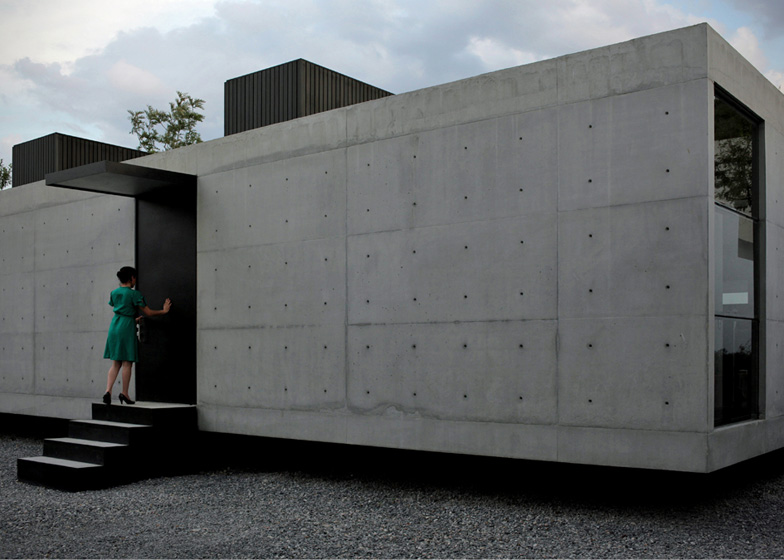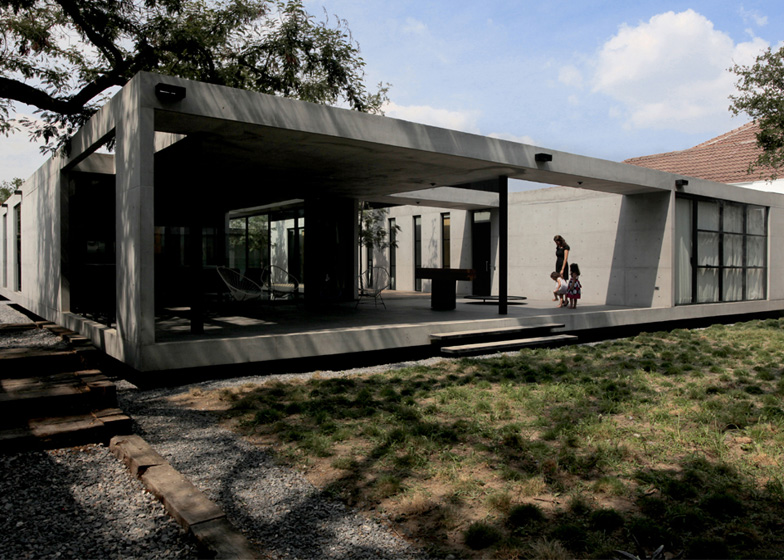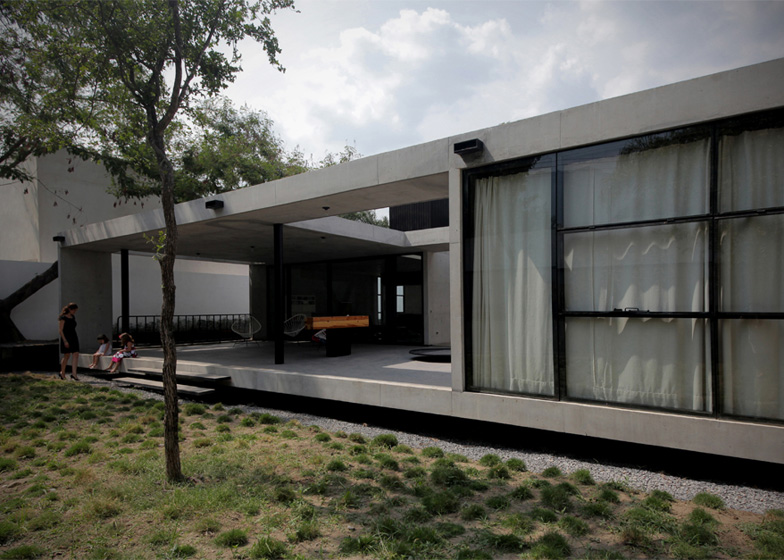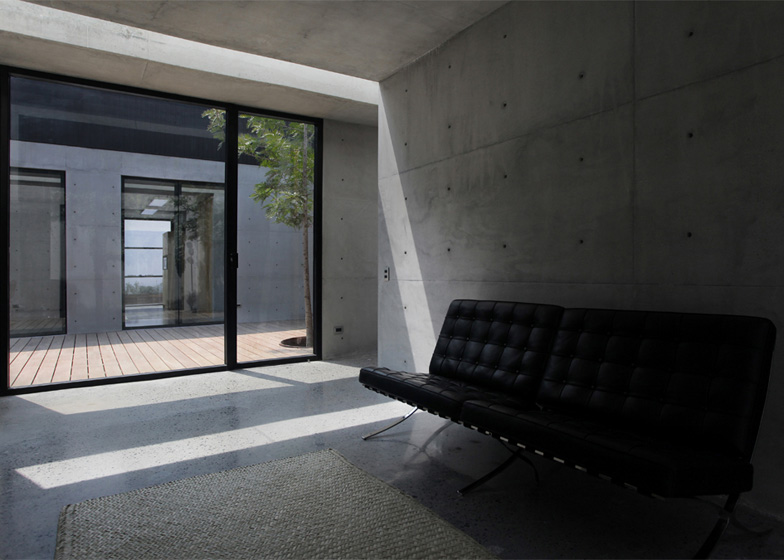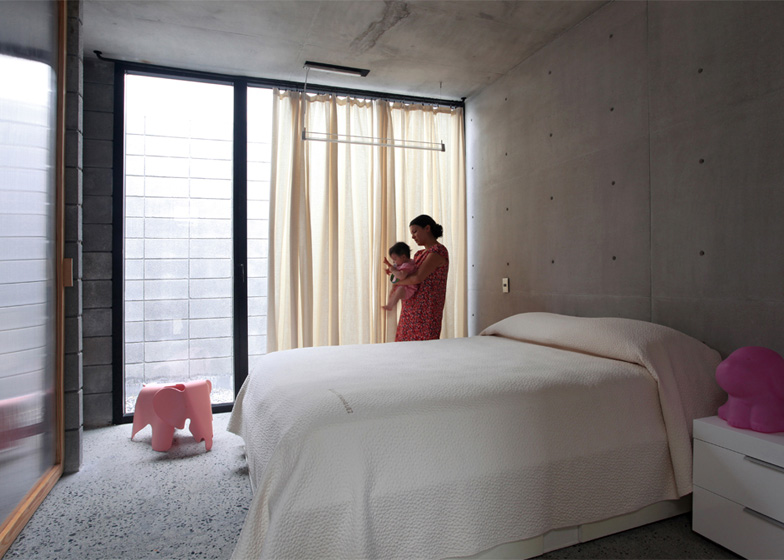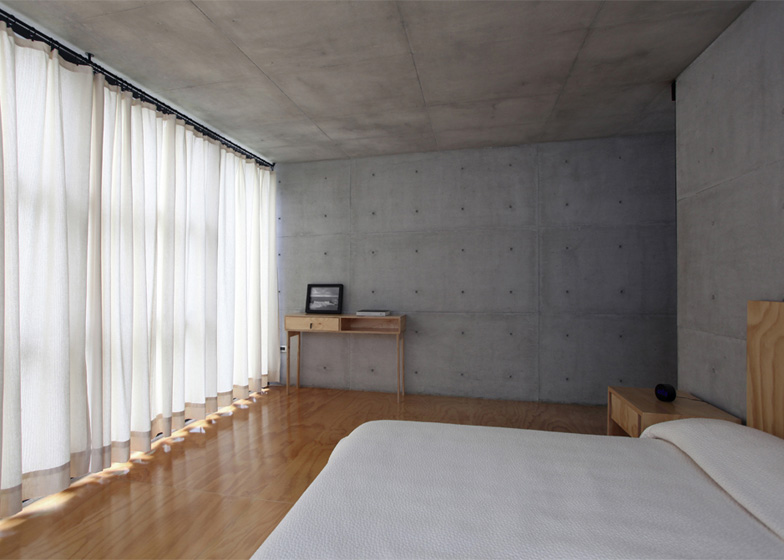A secluded courtyard is concealed behind the stark concrete facade of this house in Nuevo León, Mexico, by Monterrey studio Stación-ARquitectura (+ slideshow).
The family residence, entitled Casa 2G, is laid out on a rectangular plot. The L-shaped courtyard divides it into two halves, with living rooms on one side and bedrooms on the other.
Stación-ARquitectura were asked to make the building as basic as possible, but to also add some homely features for the residents. "The challenge was to achieve this with the least number of materials and with rational and intelligent use of them," architect César Guerrero told Dezeen.
The architects planned a bare concrete construction with minimal detailing around doors and windows. "The materials and construction processes were generated by a direct local workforce made on site," said Guerrero, "so the house combines industrial raw materials with local artisanal workmanship."
Three bedrooms and a study are lined up along the eastern side of the house. Each one opens out to a small narrow private patio, plus the bedrooms all have their own ensuite bathrooms.
The opposite side of the house has an open-plan layout with kitchen at one end, dining area at the centre and living area at the far end. Glazing surrounds two sides of the space, so residents can open the room out to the courtyard.
Rectangular skylights pierce the roof in various rooms, bringing slices of light into the house during the day.
Stación-ARquitectura, also known as S-AR, founded its studio in 2003. Past projects include a showroom and design office for a Mexican office furniture company. See more architecture in Mexico.
Photography is by Ana Cecilia Garza.
Here's some more information from S-AR:
Casa 2G - S-AR stación-ARquitectura
Casa 2G is a 360 square meter single family home designed by S-AR, an architectural firm based in Monterrey, Mexico. The house was designed as a sanctuary from the surrounding urban environment, as well as a series of memorable architectural spaces with the people that live in them at their conceptual core.
Casa 2G creates sensory experiences and moments that enrich its inhabitant's daily lives, thanks in part to its sparse materiality and handmade features, which pay tribute to the artisan work of local craftsmen. The nature of this space contrasts with false ideas of human progress in a world dominated by appearances and trends.
By taking a morning tour of Casa 2-G, the viewers are able to experience those special everyday moments spent in the house. As the windows open, we take in the natural changes in the environment, and we witness the dialogue between the house and the natural light as it evolves throughout the day. Come nightfall, the house opens up its spaces so that the light from the fire can fill us with peace as it vibrates over the raw surfaces of its walls. In Casa 2G, ordinary routine is pleasantly interrupted, and transformed into memorable moments of harmony and spiritual consciousness.
Proposed as a basic house, the project is a simple rectangular volume with a courtyard that divides the social from the private area. Located in a residential area, the volume starts few meters behind the line of the street creating a courtyard for pedestrian and vehicular access.
A concrete wall with a door is to simplify the design of the facade of the house, making it as basic as possible. However, this lack of openings to the street, contrasts with a wide open interior space that visually connects the whole social area with the central patio, the backyard and the Sierra Madre Mountains filling the interior spaces with light and natural ventilation and establishing a strong dialogue with the landscape.
The private rooms are protected by a segmented wall that allows privacy; also every private room has a private patio to bring lighting and ventilation. The social area is a continuous sequence of kitchen, dining room, lounge and a large terrace that connects to the rear garden.
Above: ground floor plan - click for larger image
Doors, windows, metalwork and construction system are the most basic possible. The materials are left in a raw and natural way. Many of them have been done on site using materials and local labor with the intention of rescuing traditional constructive systems and jobs that have been displaced by a market of prefabricated materials, which generates low local employment and architecture based on repetition and mass.
Above: section A-A' - click for larger image
Manual opening systems for windows and skylights and doors were designed especially for the project, developed by working closely with experienced local carpenters and blacksmiths. The architecture of the house invites the users to be part of their material structure. The use of the house generates a direct experience with materials, tactile sensations and a different consciousness of the elements that are part of the house in times of extreme lack of contact between people and objects and also between people and architecture. Thus 90% of the components of the house have been made by local labor and have only used the lowest number of industrial materials to preserve the essential idea of the project.
Above: section 2-2' - click for larger image
Structurally, the whole volume made of reinforced concrete made in site (walls, slabs and inverted beams) floats on a platform that helps to provide insulation for the interior space, also the orientation of the house ensures the protection of the solar incidence using the existing trees on the site which bring shade to the roof of the house and also using higher volumes of neighboring houses.
Above: north elevation - click for larger image
The house is a reinforced concrete monolith that has been perforated to create the interior space which is then defined with a glass membrane to emphasize the continuity of the material in floors, walls and slabs and its quality to be gradually transformed by the movement of the light and the shadows that occurs both inside and outside of the house during the course of the day.
Above: west elevation - click for larger image
Project: Casa 2G
Architects: S-AR stación-ARquitectura
Location: San Pedro, Nuevo Leon, Mexico
Project Team: César Guerrero, Ana Cecilia Garza, María Sevilla, Carlos Flores.
Program: Private House.
Client: Private.
Construction Area: 360 m2.
Project Year: 2009
Construction Year: 2010 - 2011
Plans and Technical Drawings: S-AR stación-ARquitectura
Model: S-AR stación-ARquitectura
Structural Engineering: Ing. Jesús González Sáenz
Technical Supervision: S-AR stación-ARquitectura + Gonzalo Taméz
Construction: Gonzalo Taméz, Enrique López, Jesús Galván
Materials: Concrete, Steel, Glass and Wood.
Constructive System: walls and slabs of reinforced concrete.

